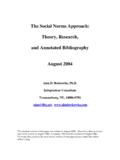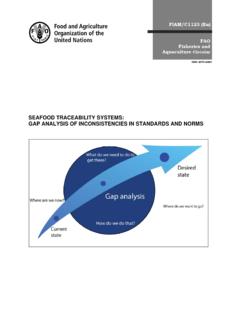Transcription of Changing cultural and social norms that support violence
1 Changing cultural and social norms that support violenceSeries of briefings on violence preventionThis briefing for advocates, programme designers and implementers and others is one of a seven-part series on the evidence for interventions to prevent interpersonal and self-directed violence . The other six briefings look at reducing access to lethal means; increasing safe, stable and nurturing relationships between children and their parents and caregivers; develop ing life skills in children and adolescents; reducing availabil-ity and misuse of alcohol; promoting gender equality; and victim identification, care and a searchable evidence base on interventions to prevent violence , please go to: a library of violence prevention publications, including the other briefings in this series, please go to: WHO Library Cataloguing-in-Publication DataChanging cultural and social norms supportive of violent behaviour.
2 (Series of briefings on violence prevention: the evidence) prevention and control. violence prevention and control. behavior. policy. Health Organization. ISBN 978 92 4 159833 0 (NLM classification: HV 6625) World Health Organization 2009 All rights reserved. Publications of the World Health Organization can be obtained from WHO Press, World Health Organization, 20 Avenue Appia, 1211 Geneva 27, Switzerland (tel.: +41 22 791 3264; fax: +41 22 791 4857; e-mail: Requests for permission to reproduce or translate WHO publications whether for sale or for noncommercial distribution should be addressed to WHO Press, at the above address (fax: +41 22 791 4806; e-mail: The designations employed and the presentation of the material in this publication do not imply the expression of any opinion whatsoever on the part of the World Health Organization concerning the legal status of any country, territory, city or area or of its authorities, or concerning the delimitation of its frontiers or boundaries.))
3 Dotted lines on maps represent approximate border lines for which there may not yet be full mention of specific companies or of certain manufacturers products does not imply that they are endorsed or recommended by the World Health Organization in preference to others of a similar nature that are not mentioned. Errors and omissions excepted, the names of proprietary products are distinguished by initial capital reasonable precautions have been taken by the World Health Organization to verify the information contained in this publication. However, the published material is being distributed without warranty of any kind, either expressed or implied. The responsibility for the interpretation and use of the material lies with the reader.
4 In no event shall the World Health Organization be liable for damages arising from its by minimum graphicsPrinted in MaltaOverviewCultural and social norms can encourage or expectations of behaviour norms within a cultural or social group can encourage violence . Interventions that challenge cultural and social norms supportive of violence can prevent acts of violence and have been widely used. This briefing describes how cultural and social norms can support violence , gives examples of interventions that often target intimate partner and youth aim to reduce dating violence and sexual abuse among teenagers and young adults by challenging attitudes and norms related to gender that, for instance, allow men control over women.
5 Many work with male peer groups, acknowledging the strong influence that young adults can have on each others behaviour. A common approach aims to correct misperceptions that people may have of the attitudes and behaviour of others. Mass media campaigns, including education through entertainment (edutainment), have also been used to challenge norms supportive of and policies can assist in altering norms linked to and policies that make violent behaviour an offence send a message to society that it is not acceptable. While nearly all governments around the world have laws against most forms of homicide, recently more governments have begun to enact and implement laws against non-lethal intimate partner rigorous evaluations of interventions that address social norms are that evaluate the effectiveness of interventions that challenge norms supportive of violence are rare.
6 Rigorous evaluations of such interventions are feasible, but they face a number of challenges, including clearly isolating the effects of the interventions from possible confounding factors and poor understanding of the mechanisms underlying changes in cultural and social to alter such norms and identifies the main challenges to rigorously evaluating such 3 Changing cultural AND social norms THAT support VIOLENCE1. Introductionprevent violent behaviour. Although widely used, they have rarely been evaluated. Given the current weak evidence base, it is premature to review their effectiveness. The aim of this briefing, therefore, is to encourage increased efforts to implement and evaluate well-designed interventions that chal-lenge cultural and social norms which support vio-lence.
7 Accordingly, this briefing: Defines cultural and social norms and illus-trates how they support violence ; Provides examples of interventions that seek to alter these norms ; and Identifies the main challenges faced by eval-uations of the effectiveness of such interven-tions. cultural and social norms are highly influential in shaping individual behaviour, including the use of violence . norms can protect against violence , but they can also support and encourage the use of it. For instance, cultural acceptance of violence , ei-ther as a normal method of resolving conflict or as a usual part of rearing a child, is a risk factor for all types of interpersonal violence (1). It may also help explain why countries experiencing high levels of one type of violence also experience increased levels of other types (2).
8 social tolerance of violent behaviour is likely learned in childhood, through the use of corporal punishment (2) or witnessing violence in the family (3,4), in the media (5) or in other settings. Interventions that challenge cultural and social norms supportive of violence can help reduce and 4 violence PREVENTION: THE EVIDENCE2. cultural and social norms that support violenceincluding sexual violence , as a private affair hin-ders outside intervention and prevents those af-fected from speaking out and gaining support (11). In many societies, victims of sexual violence also feel stigmatized, which inhibits reporting (12). Additionally, strong evidence of an association between alcohol consumption and violent behav-iour means that cultural and social norms around alcohol use and its expected effects can also en-courage and justify violent acts.
9 In a number of countries, harmful alcohol use is estimated to be responsible for 26% of male and 16% of female disability-adjusted life-years (DALYs1) lost as a re-sult of homicide (13). Societies that tolerate higher rates of acute alcohol intoxication report stronger relationships between alcohol use and violence than those where drinking occurs more moderately (14). Furthermore, alcohol-related violence is con-sidered more likely in cultures where many believe that alcohol plays a positive role by helping people to shed their inhibitions (15). Here, alcohol can be used as a justification for violent behaviour, or con-sumed to fuel the courage needed to commit vio-lent crimes.
10 Interventions that tackle the cultural and social norms underlying risky drinking behav-can help in preventing violence (16,17). For more in-formation on the relationship between alcohol and violence , see the briefing in this series on prevent- cultural and social norms are rules or expectations of behaviour within a specific cultural or social group. Often unspoken, these norms offer social standards of appropriate and inappropriate be-haviour, governing what is (and is not) acceptable and co-ordinating our interactions with others (6). cultural and social norms persist within society be-cause of individuals preference to conform, given the expectation that others will also conform (7).
















